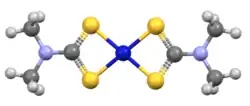Nickel bis(dimethyldithiocarbamate)
2.svg.png) | |
 | |
| Names | |
|---|---|
| Other names
Sankel, ethyl niclate; nickel dimethyldithiocarbamate
| |
| Identifiers | |
3D model (JSmol)
|
|
| ChemSpider | |
| EC Number |
|
PubChem CID
|
|
| UNII | |
| |
| |
| Properties | |
| C6H12N2NiS4 | |
| Molar mass | 299.11 g·mol−1 |
| Appearance | light green solid[1] |
| insoluble | |
Except where otherwise noted, data are given for materials in their standard state (at 25 °C [77 °F], 100 kPa).
Infobox references
| |
Nickel bis(dimethyldithiocarbamate) is the coordination complex on nickel and dimethyldithiocarbamate, with the formula Ni(S2CNMe2)2 (Me = methyl). It is the prototype for a large number of square planar bis(dialkhyldithiocarbamate)s of nickel(II), which feature diverse organic substituents. Nickel bis(dimethyldithiocarbamate) has been marketed as a fungicide, and related complexes are used as stabilizers in polymers.[2]
Preparation and structure
The compound precipitates as a light green solid upon combining aqueous solutions of nickel(II) salts and sodium dimethyldithiocarbamate.[1] In terms of structure and bonding, the nickel is square planar, and the complex is diamagnetic.[3] The structure of the closely related nickel bis(diethyldithiocarbamate) has been determined by X-ray crystallography.[4]
Oxidation of nickel bis(dieethyldithiocarbamate) gives the red-brown nickel(IV) complex [Ni(S2CNEt2)3]+.[1]
See also
References
- ^ a b c Mazumder, Md. Motiur R.; Dalpati, Niharika; Pokkuluri, P. Raj; Farnum, Byron H. (2022). "Zinc-Catalyzed Two-Electron Nickel(IV/II) Redox Couple for Multi-Electron Storage in Redox Flow Batteries". Inorganic Chemistry. 61 (48): 19039–19048. doi:10.1021/acs.inorgchem.2c03124. PMID 36413487.
- ^ Rüdiger Schubart (2000). "Dithiocarbamic Acid and Derivatives". Ullmann's Encyclopedia of Industrial Chemistry. Weinheim: Wiley-VCH. doi:10.1002/14356007.a09_001. ISBN 978-3-527-30385-4.
- ^ D. Coucouvanis (1970). "The Chemistry of the Dithioacid and 1,1-Dithiolate Complexes". Progress in Inorganic Chemistry. Vol. 11. pp. 233–371. doi:10.1002/9780470166123.ch4. ISBN 978-0-471-54081-6.
- ^ Khan, Md. N. I.; Fackler Jnr, J. P.; Murray, H. H.; Heinrich, D. D.; Campana, C. (1987). "Structure of the beta form of bis(diethyldithiocarbamato)nickel(II)". Acta Crystallographica Section C Crystal Structure Communications. 43 (10): 1917–1919. Bibcode:1987AcCrC..43.1917K. doi:10.1107/S0108270187089625.